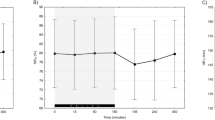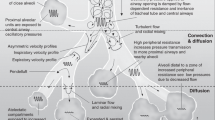Abstract
BACKGROUND:
During weaning of synchronized intermittent mandatory rate in preterm infants, the spontaneous breaths must overcome the resistance of the endotracheal tube and the disease-induced respiratory loads. Pressure Support (PS) can be used as an adjunct to synchronized intermittent mandatory ventilation (SIMV) to partially unload the spontaneous breaths.
OBJECTIVE:
To evaluate the effects of two levels of PS as an adjunct to SIMV on gas exchange and breathing effort during an acute reduction in SIMV rate in preterm infants.
METHODS:
In all, 15 infants (birth weight 793±217?g, gestational age 26.4±1.5 weeks, postnatal age 15±16 days). Ventilatory support consisted of SIMV with peak inspiratory pressure (PTP) 16.3±1.3?cmH2O, positive end-expiratory pressure (PEEP) 4.3±0.6?cmH2O, and fraction of inspired oxygen (FiO2) 0.26±0.06. Infants were studied during four 30-minute periods: Two baseline SIMV periods and two periods of SIMV plus PS, in random order. During SIMV+PS, SIMV rate was lowered by 10 breaths per minute (b/minute) and PS was set at 3 and 6?cmH2O (SIMV+PS3 and SIMV+PS6, respectively).
RESULTS:
SIMV rate was reduced during SIMV+PS from 21.4±6.6 to 11.4±6.6?b/minute. Arterial oxygen saturation, transcutaneous carbon dioxide tension and FiO2 remained unchanged. Minute ventilation, total respiratory rate and mean airway pressure were higher during SIMV+PS. Per-breath inspiratory effort was lower during SIMV+PS and this was more striking during SIMV+PS6. Spontaneous inspiratory effort per minute increased during SIMV+PS3, but this increase was averted during SIMV+PS6.
CONCLUSION:
Assistance of the spontaneous breaths with pressure support maintained gas exchange. PS of 6?cm H2O prevented an increase in breathing effort during an acute 50% reduction in SIMV rate.
This is a preview of subscription content, access via your institution
Access options
Subscribe to this journal
Receive 12 print issues and online access
$259.00 per year
only $21.58 per issue
Buy this article
- Purchase on Springer Link
- Instant access to full article PDF
Prices may be subject to local taxes which are calculated during checkout
Similar content being viewed by others
References
LeSouef PN, England SJ, Bryan AC . Total resistance of the respiratory system in preterm infants with and without an endotracheal tube. J Pediatr 1984;104:108–111.
Oca MJ, Becker MA, Dechert RE, Donn S . Relation of neonatal endotracheal tube size and airway resistance. Respir Care 2002;47 (9):994–997.
Graff MA, Novo RP, Diaz M, Smith C, Hiatt IM, Hegyi T . Compliance measurement in respiratory distress syndrome: the prediction of outcome. Pediatr Pulmonol 1986;2 (6):332–336.
Cunningham MD . Intensive care monitoring of pulmonary mechanics for preterm infants undergoing mechanical ventilation. J Perinatol 1989;9 (1):56–59.
Kavvadia V, Greenough A, Itakura Y, Dimitriou G . Neonatal function in very immature infants with and without RDS. J perinat Med 1999;27 (5):382–387.
Clark RH, Gerstmann DR, Jobe AH, Moffitt ST, Slutsky AS, Yoder BA . Lung injury in neonates: causes, strategies for prevention, and long-term consequences. J Pediatr 2001;139:478–486.
Dreyfuss D, Basset G, Soler P, Saumon G . Intermittent positive-pressure hyperventilation with high inflation pressures produces pulmonary micro vascular injury in rats. Am Rev Respir Dis 1985;132:880–884.
Gerhardt T, Bancalari E . Apnea of prematurity: II. Respiratory reflexes. Pediatrics 1984;74:63–66.
Gerhardt T, Bancalari E . Apnea of prematurity: lung function and regulation of breathing. Pediatrics 1984;74:58–62.
Gerhardt T, Bancalari E . Chest wall compliance in fullterm and premature infants. Acta Paediatr Scand 1994;69:359–364.
Heldt GP, Mcllroy MB . Distorsion of chest wall and work of diaphragm in preterm infant. J Appl Physiol 1987;62:164–169.
Tokioka H, Kinjo M, Hirakawa M . The effectiveness of pressure support ventilation for mechanical ventilatory support in children. Anesthesiology 1993;78:880–884.
Banner MJ, Kirby RR, Gabrielli A, Blanch PB, Layon AJ . Partially and totally unloading respiratory muscles based on real-time measurements of work of breathing. A clinical approach. Chest 1994;106 (6):1835–1842.
Shelledy DC, Rau JL, Thomas-Goodfellow L . A comparison of the effects of assist-control, SIMV, and SIMV with pressure support on ventilation, oxygen consumption, and ventilatory equivalent. Heart Lung 1995;24:67–75.
Brochard L, Harf A, Lorino H, Lemaire F . Inspiratory pressure support prevents diaphragmatic fatigue during weaning from mechanical ventilation. Am Rev Respir Dis 1989;139:513–521.
Sinha SK, Donn SM, Gavey J, McCarty M . Randomised trial of volume controlled versus time cycled, pressure limited ventilation in preterm infants with respiratory distress syndrome. Arch Dis Child 1997;777:F202–F205.
Author information
Authors and Affiliations
Additional information
This work was supported by University of Miami Project NewBorn and The National Institutes of Health, Fogarty Grant # 1 D43 TW01280.
Equipment grant provided by Viasys Healthcare.
This work was presented in part at the 2002 meeting of the Society for Pediatric Research.
Rights and permissions
About this article
Cite this article
Osorio, W., Claure, N., D'Ugard, C. et al. Effects of Pressure Support during an Acute Reduction of Synchronized Intermittent Mandatory Ventilation in Preterm Infants. J Perinatol 25, 412–416 (2005). https://doi.org/10.1038/sj.jp.7211303
Published:
Issue Date:
DOI: https://doi.org/10.1038/sj.jp.7211303
This article is cited by
-
State of the art in conventional mechanical ventilation
Journal of Perinatology (2009)



